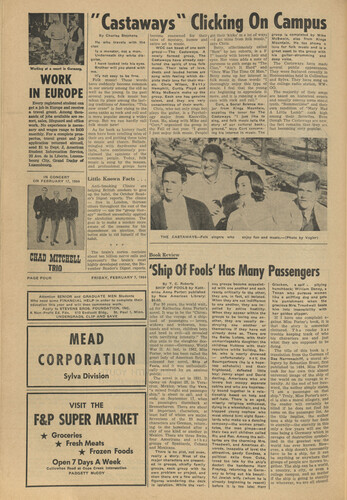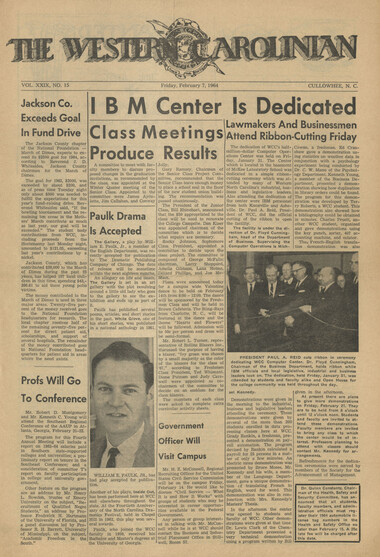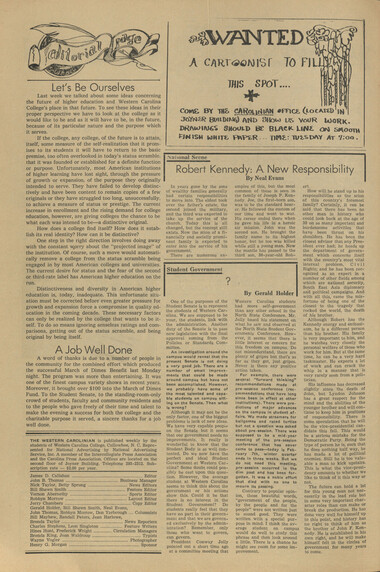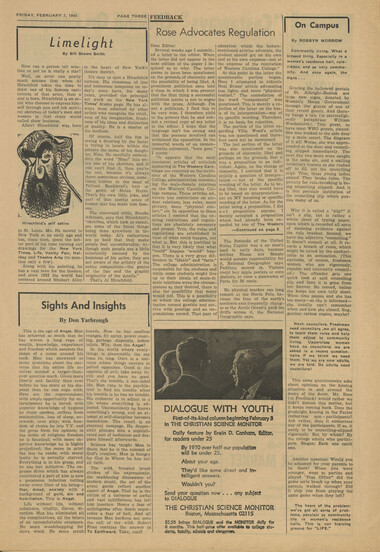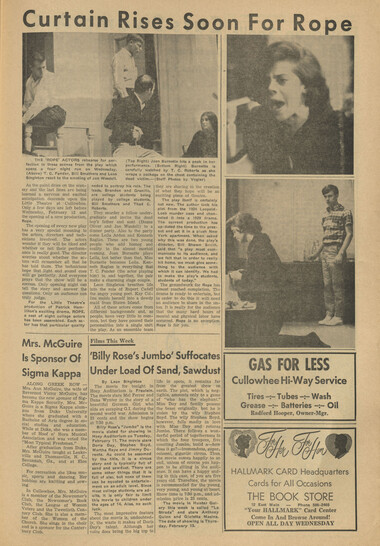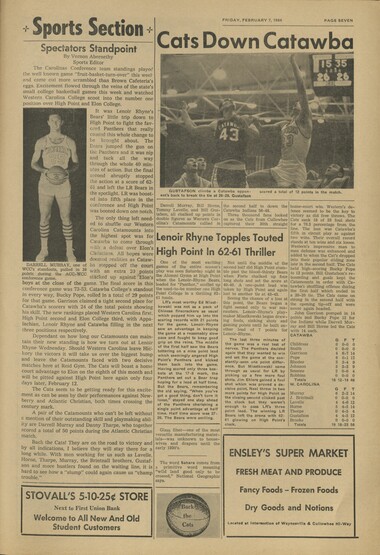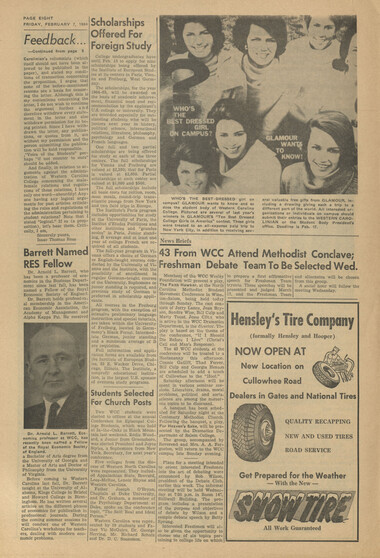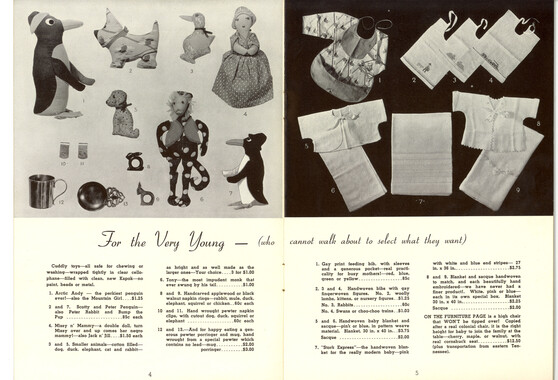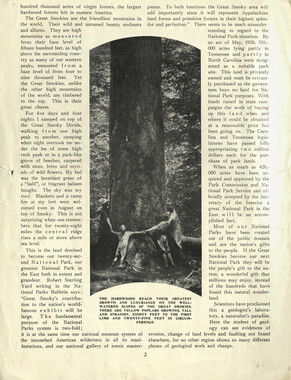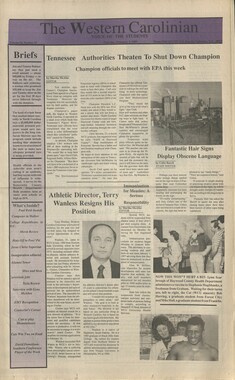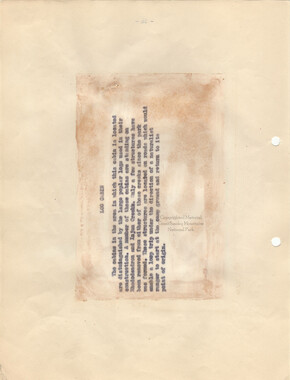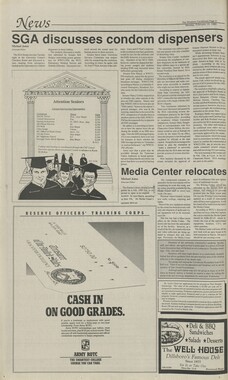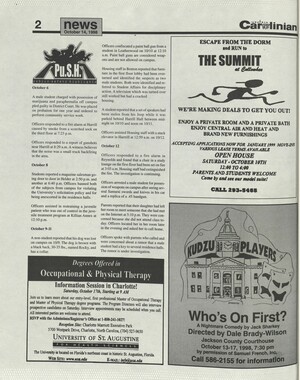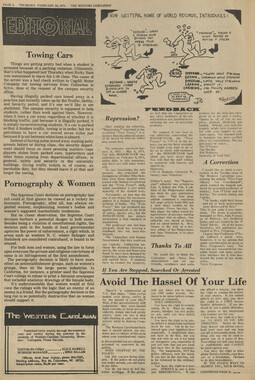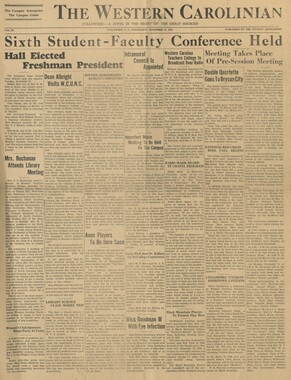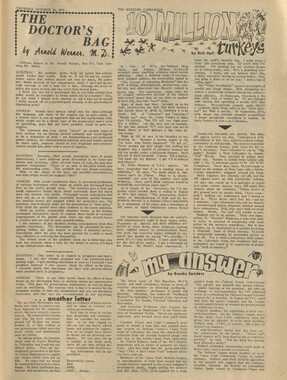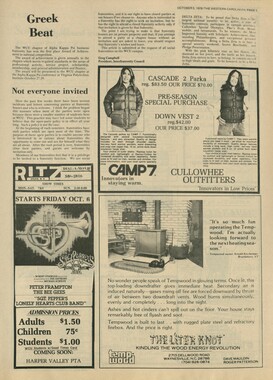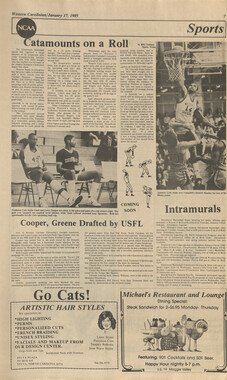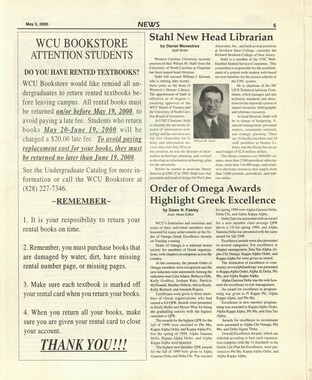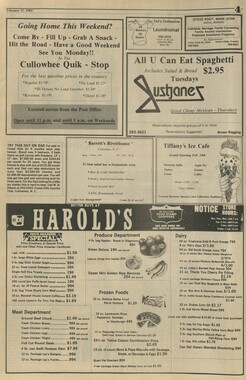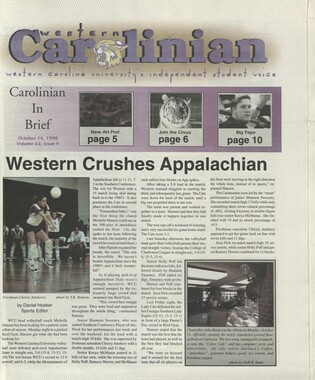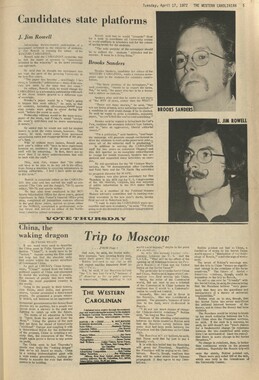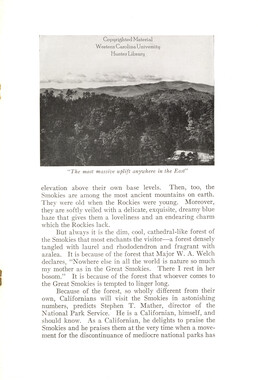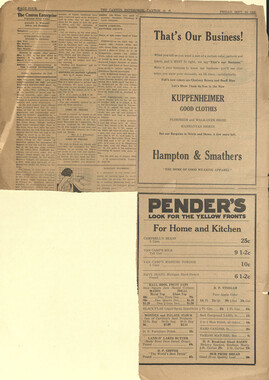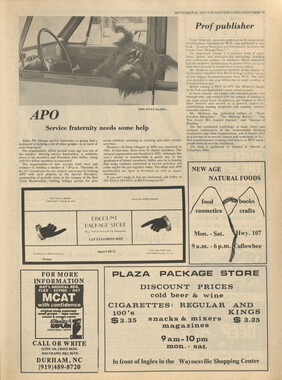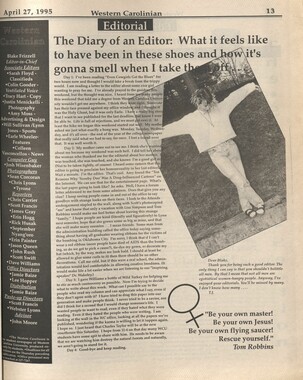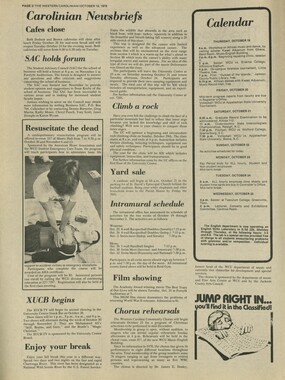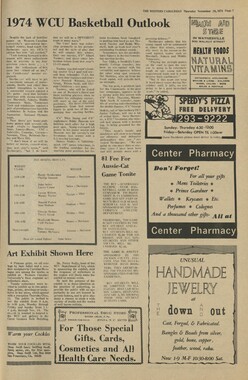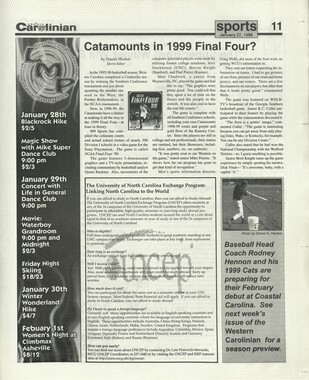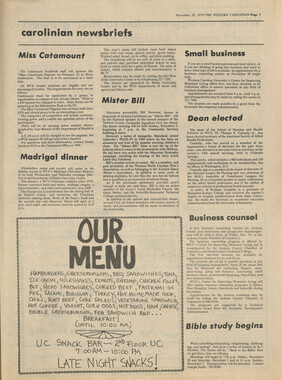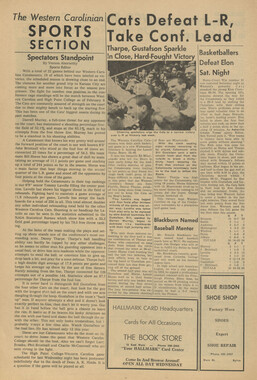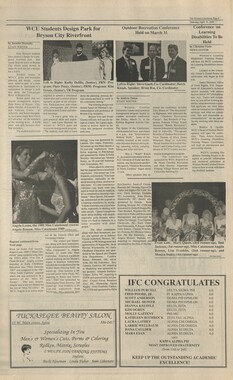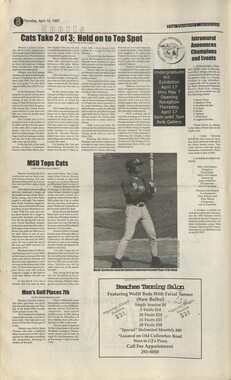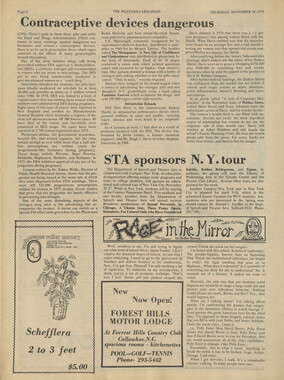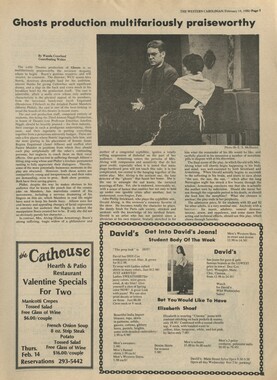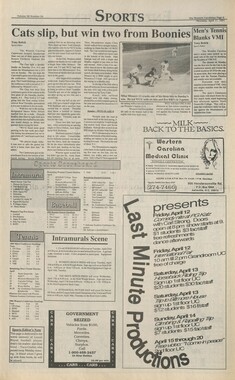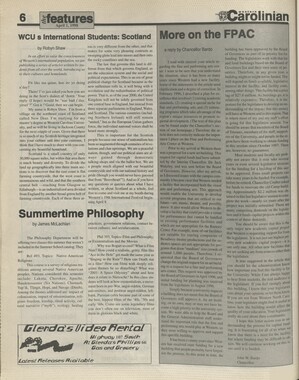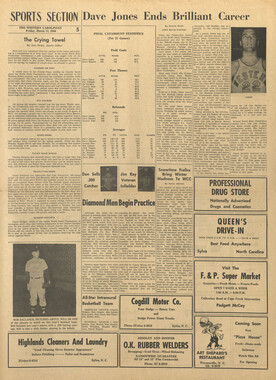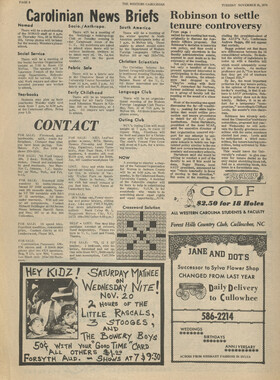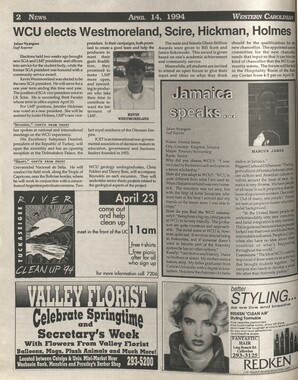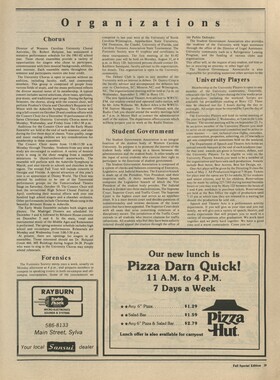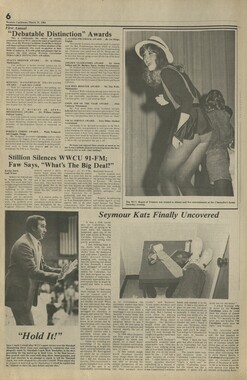Western Carolina University (20)
View all
- Canton Champion Fibre Company (2308)
- Cherokee Traditions (293)
- Civil War in Southern Appalachia (165)
- Craft Revival (1942)
- Great Smoky Mountains - A Park for America (2683)
- Highlights from Western Carolina University (430)
- Horace Kephart (941)
- Journeys Through Jackson (154)
- LGBTQIA+ Archive of Jackson County (15)
- Oral Histories of Western North Carolina (314)
- Picturing Appalachia (6679)
- Stories of Mountain Folk (413)
- Travel Western North Carolina (160)
- Western Carolina University Fine Art Museum Vitreograph Collection (129)
- Western Carolina University Herbarium (92)
- Western Carolina University: Making Memories (708)
- Western Carolina University Publications (2283)
- Western Carolina University Restricted Electronic Theses and Dissertations (146)
- Western North Carolina Regional Maps (71)
- World War II in Southern Appalachia (131)
University of North Carolina Asheville (6)
View all
- Allanstand Cottage Industries (62)
- Appalachian National Park Association (53)
- Bennett, Kelly, 1890-1974 (1295)
- Berry, Walter (76)
- Brasstown Carvers (40)
- Carver, George Washington, 1864?-1943 (26)
- Cathey, Joseph, 1803-1874 (1)
- Champion Fibre Company (233)
- Champion Paper and Fibre Company (297)
- Cherokee Indian Fair Association (16)
- Cherokee Language Program (22)
- Crowe, Amanda (40)
- Edmonston, Thomas Benton, 1842-1907 (7)
- Ensley, A. L. (Abraham Lincoln), 1865-1948 (275)
- Fromer, Irving Rhodes, 1913-1994 (70)
- George Butz (BFS 1907) (46)
- Goodrich, Frances Louisa (120)
- Grant, George Alexander, 1891-1964 (96)
- Heard, Marian Gladys (60)
- Kephart, Calvin, 1883-1969 (15)
- Kephart, Horace, 1862-1931 (313)
- Kephart, Laura, 1862-1954 (39)
- Laney, Gideon Thomas, 1889-1976 (439)
- Masa, George, 1881-1933 (61)
- McElhinney, William Julian, 1896-1953 (44)
- Niggli, Josephina, 1910-1983 (10)
- North Carolina Park Commission (105)
- Osborne, Kezia Stradley (9)
- Owens, Samuel Robert, 1918-1995 (11)
- Penland Weavers and Potters (36)
- Roberts, Vivienne (15)
- Roth, Albert, 1890-1974 (142)
- Schenck, Carl Alwin, 1868-1955 (1)
- Sherrill's Photography Studio (2565)
- Southern Highland Handicraft Guild (127)
- Southern Highlanders, Inc. (71)
- Stalcup, Jesse Bryson (46)
- Stearns, I. K. (213)
- Thompson, James Edward, 1880-1976 (226)
- United States. Indian Arts and Crafts Board (130)
- USFS (683)
- Vance, Zebulon Baird, 1830-1894 (1)
- Weaver, Zebulon, 1872-1948 (58)
- Western Carolina College (230)
- Western Carolina Teachers College (282)
- Western Carolina University (1794)
- Western Carolina University. Mountain Heritage Center (18)
- Whitman, Walt, 1819-1892 (10)
- Wilburn, Hiram Coleman, 1880-1967 (73)
- Williams, Isadora (3)
- Cain, Doreyl Ammons (0)
- Crittenden, Lorraine (0)
- Rhodes, Judy (0)
- Smith, Edward Clark (0)
- Appalachian Region, Southern (2393)
- Asheville (N.C.) (1886)
- Avery County (N.C.) (26)
- Blount County (Tenn.) (147)
- Buncombe County (N.C.) (1664)
- Cherokee County (N.C.) (283)
- Clay County (N.C.) (555)
- Graham County (N.C.) (233)
- Great Smoky Mountains National Park (N.C. and Tenn.) (478)
- Haywood County (N.C.) (3522)
- Henderson County (N.C.) (70)
- Jackson County (N.C.) (4692)
- Knox County (Tenn.) (21)
- Knoxville (Tenn.) (9)
- Lake Santeetlah (N.C.) (10)
- Macon County (N.C.) (420)
- Madison County (N.C.) (211)
- McDowell County (N.C.) (39)
- Mitchell County (N.C.) (132)
- Polk County (N.C.) (35)
- Qualla Boundary (981)
- Rutherford County (N.C.) (76)
- Swain County (N.C.) (2017)
- Transylvania County (N.C.) (247)
- Watauga County (N.C.) (12)
- Waynesville (N.C.) (68)
- Yancey County (N.C.) (72)
- Aerial Photographs (3)
- Aerial Views (60)
- Albums (books) (4)
- Articles (1)
- Artifacts (object Genre) (228)
- Biography (general Genre) (2)
- Cards (information Artifacts) (38)
- Clippings (information Artifacts) (191)
- Crafts (art Genres) (622)
- Depictions (visual Works) (21)
- Design Drawings (1)
- Drawings (visual Works) (184)
- Envelopes (73)
- Facsimiles (reproductions) (1)
- Fiction (general Genre) (4)
- Financial Records (12)
- Fliers (printed Matter) (67)
- Glass Plate Negatives (381)
- Guidebooks (2)
- Internegatives (10)
- Interviews (811)
- Land Surveys (102)
- Letters (correspondence) (1013)
- Manuscripts (documents) (619)
- Maps (documents) (159)
- Memorandums (25)
- Minutes (administrative Records) (59)
- Negatives (photographs) (5651)
- Newsletters (1285)
- Newspapers (2)
- Occupation Currency (1)
- Paintings (visual Works) (1)
- Pen And Ink Drawings (1)
- Periodicals (193)
- Personal Narratives (7)
- Photographs (12982)
- Plans (maps) (1)
- Poetry (5)
- Portraits (1655)
- Postcards (329)
- Programs (documents) (151)
- Publications (documents) (2237)
- Questionnaires (65)
- Scrapbooks (282)
- Sheet Music (1)
- Slides (photographs) (402)
- Sound Recordings (796)
- Specimens (92)
- Speeches (documents) (15)
- Tintypes (photographs) (8)
- Transcripts (322)
- Video Recordings (physical Artifacts) (23)
- Vitreographs (129)
- Text Messages (0)
- A.L. Ensley Collection (275)
- Appalachian Industrial School Records (7)
- Appalachian National Park Association Records (336)
- Axley-Meroney Collection (2)
- Bayard Wootten Photograph Collection (20)
- Bethel Rural Community Organization Collection (7)
- Blumer Collection (5)
- C.W. Slagle Collection (20)
- Canton Area Historical Museum (2110)
- Carlos C. Campbell Collection (198)
- Cataloochee History Project (65)
- Cherokee Studies Collection (4)
- Daisy Dame Photograph Album (5)
- Daniel Boone VI Collection (1)
- Doris Ulmann Photograph Collection (112)
- Elizabeth H. Lasley Collection (1)
- Elizabeth Woolworth Szold Fleharty Collection (4)
- Frank Fry Collection (95)
- George Masa Collection (173)
- Gideon Laney Collection (452)
- Hazel Scarborough Collection (2)
- Hiram C. Wilburn Papers (28)
- Historic Photographs Collection (236)
- Horace Kephart Collection (861)
- Humbard Collection (33)
- Hunter and Weaver Families Collection (1)
- I. D. Blumenthal Collection (4)
- Isadora Williams Collection (4)
- Jesse Bryson Stalcup Collection (47)
- Jim Thompson Collection (224)
- John B. Battle Collection (7)
- John C. Campbell Folk School Records (80)
- John Parris Collection (6)
- Judaculla Rock project (2)
- Kelly Bennett Collection (1314)
- Love Family Papers (11)
- Major Wiley Parris Civil War Letters (3)
- Map Collection (12)
- McFee-Misemer Civil War Letters (34)
- Mountain Heritage Center Collection (4)
- Norburn - Robertson - Thomson Families Collection (44)
- Pauline Hood Collection (7)
- Pre-Guild Collection (2)
- Qualla Arts and Crafts Mutual Collection (12)
- R.A. Romanes Collection (681)
- Rosser H. Taylor Collection (1)
- Samuel Robert Owens Collection (94)
- Sara Madison Collection (144)
- Sherrill Studio Photo Collection (2558)
- Smoky Mountains Hiking Club Collection (616)
- Stories of Mountain Folk - Radio Programs (374)
- The Reporter, Western Carolina University (510)
- Venoy and Elizabeth Reed Collection (16)
- WCU Gender and Sexuality Oral History Project (32)
- WCU Mountain Heritage Center Oral Histories (25)
- WCU Oral History Collection - Mountain People, Mountain Lives (71)
- WCU Students Newspapers Collection (1744)
- Western North Carolina Tomorrow Black Oral History Project (69)
- William Williams Stringfield Collection (2)
- Zebulon Weaver Collection (109)
- African Americans (388)
- Appalachian Trail (32)
- Artisans (521)
- Cherokee art (84)
- Cherokee artists -- North Carolina (10)
- Cherokee language (21)
- Cherokee pottery (101)
- Cherokee women (208)
- Church buildings (166)
- Civilian Conservation Corps (U.S.) (110)
- College student newspapers and periodicals (1830)
- Dams (94)
- Dance (1023)
- Education (222)
- Floods (60)
- Folk music (1015)
- Forced removal, 1813-1903 (2)
- Forest conservation (220)
- Forests and forestry (917)
- Gender nonconformity (4)
- Great Smoky Mountains National Park (N.C. and Tenn.) (154)
- Hunting (38)
- Landscape photography (10)
- Logging (103)
- Maps (84)
- Mines and mineral resources (8)
- North Carolina -- Maps (18)
- Paper industry (38)
- Postcards (255)
- Pottery (135)
- Railroad trains (69)
- Rural electrification -- North Carolina, Western (3)
- School integration -- Southern States (2)
- Segregation -- North Carolina, Western (5)
- Slavery (5)
- Sports (452)
- Storytelling (245)
- Waterfalls -- Great Smoky Mountains (N.C. and Tenn.) (66)
- Weaving -- Appalachian Region, Southern (280)
- Wood-carving -- Appalachian Region, Southern (328)
- World War, 1939-1945 (173)
Western Carolinian Volume 29 Number 15
Item
Item’s are ‘child’ level descriptions to ‘parent’ objects, (e.g. one page of a whole book).
-
-
if Castaways1' Clicking On Campus Working at • resort in Germany. WORK IN EUROPE Every registered student can get a job in Europe and receive a travel grant. Among thousands of jobs available are resort, sales, lifeguard and office work. No experience is necessary and wages range to $400 monthly. For a complete prospectus, travel grant and Job application returned airmail, send $1 to Dept. J, American Student Information Service, 22 Ave. de la Liberte, Luxembourg City, Grand Duchy of Luxembourg. IN CONCERT ON FEBRUARY 17, 1964 By Charles Stephens He who travels with the clan Is a monster, not a man. Underneath thy white disguise, I have looked into his eyes. Brother will you stand with me. It's not easy to be frne. Folk music! These words have suddenly become common in our society among the old as well as the young. In the past several years, folk music has taken its place among the lasting traditions of America. "This new craze" is fast rising to the same ranks as rock and roll and is more popular among a wider group. But we can hardly call folk music new! As far back as history itself, men have been retelling tales of their era and putting these tales to music and chants. Ballads, mingled with daydreams and facts, have continuously proclaimed the opinions of the common people. Today, folk music is sung by the masses, and professional groups have become renowned for their tales of mystery, humor and satire set to music. WCC can boast of one such group — The Castaways. A newly formed group, The Castaways have already captured the spirit of true folk music. Their tales of love, death and lauded heroes are sung with feeling which depicts their love for their music. Chris Wilson, Betty Hemphill, Curtis Floyd and Mike McSwain make up the group. Each one has genuine talent, and they are very conscientious of their work. Chris, who not only sings but plays the guitar, is a Psychology major from Knoxville, Tenn. He, along with Mike and "Curt," organized the group in the Fall of last year. "I guess I just enjoy folk music. People get their 'kicks' in a lot of ways —I get mine from folk music," says Chris. Betty, affectionately called "Sam" by her cohorts, is a 5' 7" beauty with brown hair and eyes. Her voice adds a note of pureness to such songs as "The Clan," "Ain't It Hard" and "Once Was The Time Of Man." Betty sums up her interest in folk music in these words: "I thoroughly enjoy this type of music. I feel that the young are beginning to appreciate it more, and it is running a close race with rock and roll." Curt, a Social Science major from Kings Mountain, supplies the tenor for The Castaways. "I just like to sing, and folk music tells the story of our cultural back-_. ground," Says Curt concerning his interest In music. The group is completed by Mike McSwain, also from Kings Mountain. He too shows a love for folk music and is a great asset to the group with his guitar-strumming and deep voice. The Castaways have made several public appearances. They were featured recently in Hootenannies held in Cullowhee and Sylva. They have sung on the college radio station, WWOO. The majority of their songs are based on historical events and usually convey some moral truth. "Summertime" and their own rendition of "Mary Had A Little Lamb" rank high among their favorites. Even though The Castaways are new, the fact remains that they are fast becoming very popular. CSAO MITCHELL TRIO Little Known Facts . . . Anti-Smoking Clinics are helping British smokers to give up the habit, the October Reader's Digest reports. The clinics —■ five in London, thirteen others throughout the rest of the country — use the "group therapy" method sucessfully applied by alcoholics anonymous. The goal is to make a smoker more aware of the reasons for his dependence on nicotine, thus better able to rid himself of the habit. The brain's cortex contains about ten billion nerve cells and represent's the brain's most highly developed center, the November Reader's Digest reports. PAGE FOUR FRIDAY, FEBRUARY 7, 1964 Attention SENIOR and GRADUATE MEN Students Who need some FINANCIAL HELP in order to complete their education this year and will then commence work. Apply to STEVENS BROS. FOUNDATION, INC. A Non-Profit Ed. Fdn. 610 Endicott Bldg., St. Paul 1, Minn. UNDERGRADS, CLIP AND SAVE MEAD CORPORATION Sylva Division i I 1 iilHH Jill! THE CASTAWAYS—Folk singers who enjoy fun and music—(Photo by Vogler) Book Review 'Ship Of Fools1 Has Many Passengers VISIT THE F&P SUPER MARKET it Groceries it Fresh Meats it Frozen Foods Open 7 Days A Week Cullowhee Road at Cope Creek Intersection PADGETT McCOY By T. C. Roberts SHIP OF FOOLS by Katherine Anne Porter; published by New American Library; $6.50. For 30 years, the world waited for Katherine Anne Porter's novel. It was to be the "Chronicles of the voyage of a shipload of passengers — lovers, widows and widowers, husbands and wives, children born and bred in evil—all revealed with terrifying intensity." The ship sails to the slaughter destined to come—Germany, World War II. At last, in 1962, Miss Porter, who has been called the great lady of American fictio.i, released her novel, Ship of Fools, and it was enthusiastically received by an anxious public. The novel is set in 1931. It opens on August 23, in Veracruz, Mexico, when the Vera, "a mixed freight and passenger ship," is about to sail, and it ends on September 17, when its passengers disembark at Bremerhaven. There are about 50 important characters, at least half of whom are major. Seventeen of the 25 major characters are German, returning to the homeland after a stay of one kind or another in Mexico. There are three Swiss, four Americans and other groups of Spaniards, Cubans and Mexicans. There is no plot, not even, really a story. Most of the major characters are presented in groups, chiefly family groups, each group with its own problem or project, and then there are a few solitary figures wandering the deck in isolation. While the vari ous groups become acquainted with one another and each reacts critically to the other, they are, in fact, all isolated. When they are not indifferent to one another, they are impelled by active hostility. When they appear within the groups to be loving one another, they are usually destroying one another or themselves if they have not already done so. There are the Swiss Lutzes, with their unmarriageable daughter; the childless Huttens with their repulsive white bulldog, Be- be, who Is nearly drowned — unfortunately not; the Baumgartners (he is a hopeless achoholic) and their frightened, defeated little boy; Jenny angel and David darling, Americans who are lovers but occupy separate cabins and who are hopelessly bound together in a relationship based on hate and self-hate. There is an aged, miserly religious enthusiast, dying in a wheelchair, and his trapped young nephew who must attend him; eight Span- lards who make up a dancing company—the women prostitutes, the men pimps—and their two evil children called Ric and Rac. Among the solitaries are the charming Mrs. Treadwell, and American divorcee, incapable of love; the attractive, gaudy Condesa, a political exile from Cuba, loved too late by the ship's doctor; the handsome Herr Freytag, returning to Germany to bring out his beautiful Jewish wife (whom he Is already beginning to resent) before it is too late; Herr Glocken, a self - pitying hunchback; William Denny, a Texan who pursues women like a sniffing dog and gets his punishment when the gracious Mrs. Treadwell beats him Into insensibility with her golden slipper. If I have one complaint a- gainst Miss Porter's book, it is that the story is somewhat cluttered. The reader has trouble keeping track of who his characters are and just what they are supposed to be doing. The title of this book is r translation from the German cf Das Narrenschiff, a moral allegory by Sebastian Brant, first published in 1494. Miss Porter took for her own this almost universal image of the ship of the world on its voyage to e- ternity. At the end of her foreword, the author simply states, "I am a passenger on that ship." Truly, Miss Porter's novel is also a moral allegory, and the reader will certainly be blind if he does not find his name on the passenger list. As the title implies, the author uses a ship to carry her fools to eternity—the eternity in this only a few years will see the case being a Germany which in ravages of destruction symbolized in the greatest war the world has ever known. However, a ship doesn't necessarily have to be a ship, for it can be anything or anywhere that groups of people are thrown together. The ship can be a world, a country, a city, or even a college campus, and no matter if the ship is going to eternity or wherever, we are all aboard.
Object
Object’s are ‘parent’ level descriptions to ‘children’ items, (e.g. a book with pages).
-
The Western Carolinian is Western Carolina University’s student-run newspaper. The paper was published as the Cullowhee Yodel from 1924 to 1931 before changing its name to The Western Carolinian in 1933.
-

